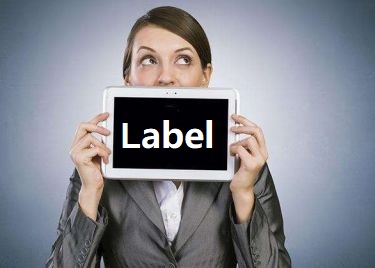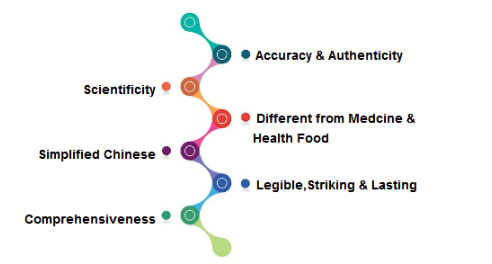


According to the relevant laws and regulations and standards (please see reference documents), labelling requirements in China are summarized as 6&10, which means 6 principles and 10 factors for food labelling, more details please see the below:
6 principles:

1. Accuracy &Authenticity
Reflect the true nature of the product actually without false information, exaggeration, not misleading and cheating.
2. Scientificity
Have scientific basis, no propaganda violating science as superstition and pornography, etc., and do not belittle other foods.
3. Different from medicine & health food
Do not perform the propaganda of having prevention, treatment and health care functions either expressed or implied.
4. Simplified Chinese
Simplified Chinese must be used, other language fonts shall not be greater than the corresponding Chinese characters.
5. Legible, striking and lasting
Separated from the food, the character height must be greater than 1.88mm, the character of net content shall be higher.
6. Comprehensiveness
All label factors of corresponding food shall be identified.
10 fatcors
1. Product name
2. The list of ingredient
3. Net weight
4. Product standard
5. Production date& shelf life
6. Storage conditions
7. Enterprise information
8. Nutritional table
9. Number of food production license
10. Labelling requirements of other standards, laws and regulations
1. Product name
The special name reflecting the true nature of the food shall be clearly indicated on the prominent place of the food label.
When labelling the “Coined name”, “Fanciful name”, “Transliterated name”, “Brand name”, “Folk name” or “Trade name”, the name complying with the provisions of 4.1.2.1 in GB7718-2011 shall be indicated on the same display panel.
There shall appear on the label either before or after the name of the food, such additional words or phrases as necessary to avoid misleading or confusing the consumer in regard to the true nature, physical condition of the food, or method of preparation of the food; for example dried, concentrated, reconstituted, cured, fried, powdery, granular and etc.
2. List of ingredients
The list of ingredients shall be titled “Ingredients” or “List of ingredients”;
All ingredients shall be listed in descending order of their quantity added in the process of production or preparation of the food; those ingredients constituting less than 2% of the food may not be listed in descending order;
Where the sweeteners, preservatives, coloring agents were directly used in food, the specific name shall be indicated under the food additives items of list of ingredients;
Where other food additives were used, the specific name, type or code shall be indicated.
The labelling of compound ingredients in the list of ingredients can be divided into the following two conditions:
(I) If the compound ingredients added directly to food have nationals, industrial or local standards and their added amount constituting less than 25% of the food, there is no need to indicate the original ingredients of the compound ingredients. In the case of the compound ingredients constituting less than 25% of the food, if there is any food additive in the above-mentioned compound ingredients, and the food additive complies with the carry-over principle stated in GB 2760 and serve no technological functions in the final product, then the food additive needs not be indicated, but the food additives in compound ingredients shall be indicted if they served technological functions in the final product. Recommended labelling method: add parentheses after the name of the compound ingredient, with the generic name of the food additive in parentheses, eg “Soy sauce (with caramel color)”.
(II) If the compound ingredients added directly to food have no national standards, industrial standards or local standards, or this compound ingredient has the national standard, industrial standard or local standard with the added amount constituting less than 25% of the food, the name of the compound ingredients shall be indicated on the list of ingredients followed by parentheses, and the original ingredients of the compound ingredients shall be indicated in the descending order of the addition amount, and ingredients with addition amount less than 2% the shall not be arranged in descending order.
3. Net weight
Quantitative prepackaged food shall be indicated with net content, the labelling of net content shall be composed by net content, figures and legal units of measurement. Such as “Net content: 450 g”, or “Net content: 450 g”;
The net content of food in the packaging (container) shall be indicated according to legal units of measurement of the “Administrative measures for the supervision of the quantitative prepackaged commodities” as follows:
1) Liquid food, by volume L (1) (liters), mL (ml) (milliliter);
2) Solid food, by mass-g (g), kg (kg);
3) Semi-solid or sticky food, by mass or volume.
The net content shall be in the same display panel as the food name in the packaging or container.
In the case of a solid food packed in a liquid medium, and the solid matter is the major ingredient of the food (such as canned pear in syrup), in addition to indicating net content, the drained (solid) content shall also be indicated in mass or mass fraction.
4. Product standard
Prepackaged food (excluding imported prepackaged foods) that are produced domestically and sold domestically shall be indicted with the standard code and serial number of the product.
5. Production date & shelf life
Date labelling shall be clear without paste-over, supplement, or amendment.
Where production dates and shelf life of many single prepackaged foods in the same prepackage are indicated, the shelf life indicated in the outer package means the shelf life of the single prepackaged food which shall expire first of all. The production date indicated in the outer package means the production date of the single food produced at the earliest or the date on which the outer package becomes a marketable product; the production date and the shelf life of each single prepackaged food may be declared in the outer packaging as well.
The date coding shall be indicated in the sequence of the year, month and day. If not indicated in this sequence, the sequence of date coding shall be indicated clearly.
6. Storage conditions
7. Enterprise information
Name, address and contact information of food producer of prepackaged food shall be indicated. The place of origin of food shall be indicated, and the place of origin shall be expressed in prefecture-level region according to the administrative division. Name and address of producer who is capable of taking the responsibility for safety and quality of products shall be legally registered.
For imported prepackaged food, the name of the country or region (such as Hong Kong, Macao and Taiwan) of origin, and the name and address of the agent, importer or distributor registered by law in the People's Republic of China, shall be indicated.
8. Nutritional table
Technical requirements of nutritional information:
Labelling forms: table title “Nutritional information” + “Box table”;
Labelling contents: Items, per 100 g (ml), NRV%, at least 1 + 4 items (energy / calories, protein, fat, carbohydrates, sodium).
Nutrition claims: Descriptions and statements about the nutritional characteristics of food include content claims and comparative claims.
Content claim: A claim that describes the level of energy or nutritional t content in a food product, such as “Contains”, “High”, “Low’, or “none”. The nutritional contents listed in Table C.1 in Annex C of GB28050-2011 can be claimed, and the corresponding requirements shall be met.
Comparative claims: A claim after comparing with the energy value or nutritional content of the same type of food well known to consumers, such as “Increasing”, “Decreasing” and so on. The condition of comparative claim is a difference of> 25% in energy value or nutritional content with reference food.
The expressions of comparative claims are divided into two categories of “Increasing” and “Decreasing”, and the corresponding synonyms can be selected according to the characteristics of food. See Table C.4 of Annex C of GB 28050-2011,.
Functional claims of nutritional content refer to the claims that a nutritional component can maintain the normal growth, development and normal physiological functions of the human body, the same product can simultaneously have functional claims on two or more ingredients complying with the requirements. One or more of the corresponding standard terms of functional claims can be chosen according to the nutritional characteristics of food only when the energy or nutritional content complying with the requirements and conditions of Annex C nutritional claims in GB28050-2011. For example, functional claim terms such as “Calcium helps bone and tooth development” shall only be indicted when the calcium content of the food meets the conditions and requirements of “Calcium source”, “High calcium” or “Increased calcium”.
9. Number of food production license
The food produced domestically shall be indicated with the number of food production license.
10. Labelling requirements of other standards, laws and regulations
Irradiated food: the label of a food which has been treated with ionizing radiation or ionizing energy shall be indicated with “irradiated food” in close proximity to the name of the food. Any ingredient which has been treated with ionizing radiation or ionizing energy shall be indicated in the list of ingredients.
>Genetically modified food or food containing statutory genetically modified as raw materials: the biological labeling of genetically modified such as “Genetically modified XX food” or “Food with genetically modified XX food as raw materials” shall be indicated.
R
Reference documents:
GB 7718-2011 “General Standard for the labelling of prepackaged foods” and the questions and answers (revised edition)
GB13432-2013 “National food safety standard Labelling of Prepackaged Foods for Special Dietary Uses” and the questions and answers (revised edition)
GB 28050-2011 “National food safety standard General Rules for Nutrition Labelling of Prepackaged Foods” and the questions and answers (revised edition)
“Administrative provisions for food labelling”
“Food safety Law of the People's Republic of China”
Please note: Original English article of Global Foodmate of Information Service and Business Department, please indicate the source from the Global Foodmate if reprint.
Need help or have a question?
Send mail